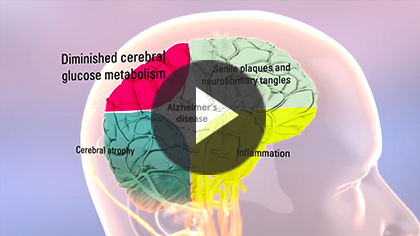Exercise and Alzheimer’s disease
Moderate exercise may lower the risk of developing Alzheimer’s disease and other dementias1,2
 Mounting evidence suggests staying physically active may lower the risk of developing dementia, slowing cognitive decline. While this is still an open-ended question, studies are finding an association between physical activity, dietary elements, and a reduction of dementia in older adults.
Mounting evidence suggests staying physically active may lower the risk of developing dementia, slowing cognitive decline. While this is still an open-ended question, studies are finding an association between physical activity, dietary elements, and a reduction of dementia in older adults.
According to a study in the medical journal Stroke, physical activity lowered the risk of vascular-related dementia by 40% and cognitive impairment by 60%. This effect was seen in people regardless of age, education, changes in the brain, or a previous history of stroke or diabetes. Other studies have suggested there may also be a link between dietary choices and cognitive decline.
Physical activity may provide a benefit in Alzheimer’s disease3
These studies suggest that people with Alzheimer’s disease may benefit from physical activity. If your loved one has Alzheimer’s disease, starting an exercise program may help. Make sure you check with your doctor before beginning any exercise program. In addition to any cognitive benefits you may see with exercise, it’s a good idea to have your loved one remain active to prevent the health conditions often associated with inactivity.
What to consider before creating an exercise program3
An exercise program for someone with Alzheimer’s disease promotes a normal daily routine, improves mood, and prevents muscle weakness and other health conditions. Repetitive activities like walking, indoor bicycling, and folding laundry that do not require decision-making are recommended. Performing these activities may also help decrease anxiety. It is recommended that you consult other professionals before creating an exercise program for your loved one.
- Warm up — Before your loved one begins the exercise routine, make sure he or she warms up and takes the time to cool down after it is over
- Start slowly — For a 30-minute workout, have your loved one start with a 10-minute session and work up to longer sessions
- Consider swimming and water aerobics — These types of exercises require less balance and are easier on the joints
- Choose a safe environment — Avoid slippery floors, throw rugs, areas with poor lighting, and other potential dangers
- Maintain balance — Exercise within reach of a grab bar or rail. If your loved one has trouble standing or getting up, exercise on the bed or an exercise mat, rather than on the floor
Make sure to supervise your loved one during exercise to help prevent injuries or accidents. If your loved one feels sick or experiences any pain, stop the activity. If a strenuous workout is not an option, choose an activity for him or her that offers the benefits of an exercise program. Physical activities such as gardening, yoga, and Tai Chi may be a better option.
Ultimately, the Alzheimer’s symptoms, general fitness level, and overall health of your loved one will help to determine which exercise program is best. Physical exercise will not stop the progression of Alzheimer's disease; however, recent studies suggest that continued exercise can provide potential benefits. Make sure you check with your loved one’s doctor or healthcare professional before he or she begins any exercise program.


